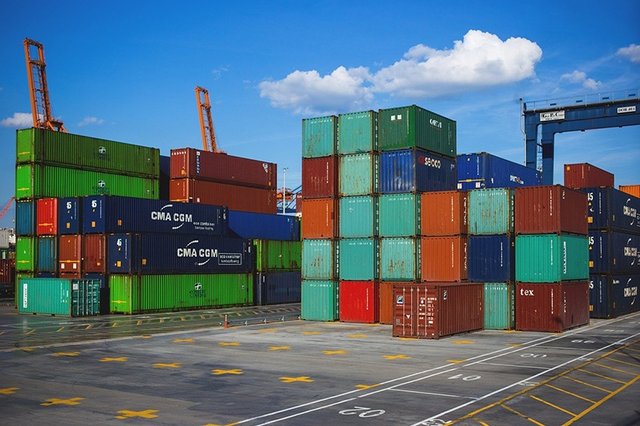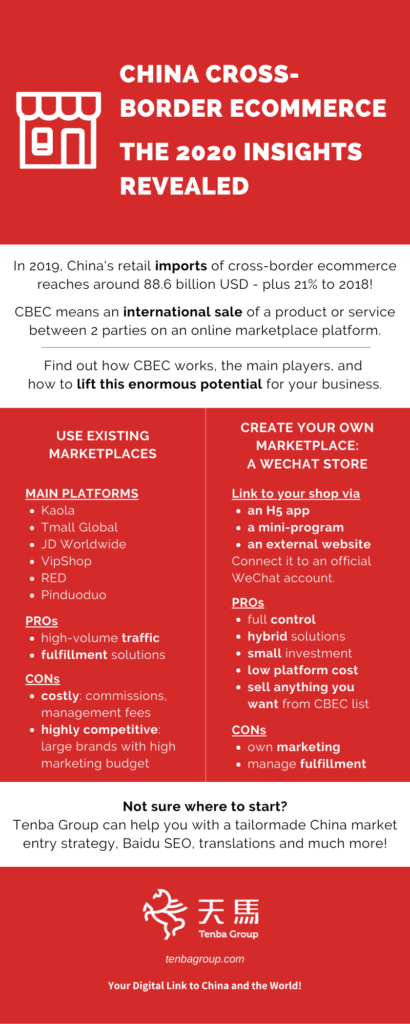The 2020 China Cross Border Ecommerce Insights

To say that the China Cross Border Ecommerce (CBEC) is booming is an understatement. The import and export trade is as old as mankind, but this year, the numbers are skyrocketing!
Whereas in the past, China was a main player for sourcing goods and exporting them to the world via dropshipping, Amazon FBA and so on, today, a new trend is on the horizon.
Back in 2014, China exported goods with a total value of more than 2.3 trillion USD and imported goods with a value of 1.96 trillion USD, giving it the nickname as the “world’s factory”. Now, in 2019, the exports are more than 221 billion USD whereas the imports to China exceed 183 billion USD.
Out of these imports, China's retail imports of cross-border ecommerce Chinese CBEC reaches around 88.6 billion USD in 2019 - an impressive 21% increase compared to the previous year. Businesses in China and worldwide are waiting in line to get a piece of this cake.
And this is not the end. During the 10th China Cross-border ecommerce Conference & Exhibition and the 5th Global E-Retailing China Summit in November 2019, more than 500 delegates from over 20 countries discussed growth strategies, further market entries, the opportunities of AI, and more.
In this week’s blog article by Tenba Group, we will explain everything you need to know about CBEC in China, the main platforms, how they work, and the benefits for your business. Let’s get started!
What is cross border ecommerce?
Generally speaking, cross border ecommerce refers to any international sale of a product or service between two parties on an online marketplace platform. We can differentiate between:
- B2C: Trade between a business (retailer or brand) and a consumer
- B2B: Trade between two businesses, often brands or wholesalers
- C2C: Trade between two individuals (non-formal business, e.g. unlicensed Daigous)
The product is shipped to the customer in China either directly via direct-shipping or through a warehouse in a free-trade zone. The VAT, customs fees, and delivery fees to the customer are then passed on to the customer. Sellers have to consider this when determining the final retail price, together with the marketing fee, management cost, and own profit margin.
CBEC in China
In China, CBEC holds a specific distinction where international companies can sell their products to Chinese customers at preferential duty rates and without a license to operate a business in the country. Most cross border trades are performed by companies from other Asian countries led by Japan and Korea, followed closely by the United States.

Since January 2019, The Chinese Ministry of Finance introduced new regulations for cross-border purchases. The most relevant ones are:
- The single-transaction amount increased from 2,000 RMB (291 USD) to 5,000 RMB (727 USD)
- The annual amount of cross-border purchases increased from 20,000 RMB (2,909 USD) to 26,000 RMB (3,782 USD) per individual
- 63 new items categories were added to the positive list for CBEC purchases, including sparkling wine, beer, health care products, and fitness equipment.
- The cities included in the CBEC tax-rebate were expanded from 15 to 37 cities, including Beijing and Shanghai.
- The new regulation makes it harder for Daigou to go about their business illegally
Popular CBEC products
The new-rich millennials in China are practically chasing exclusive luxury goods. High-quality usually refers to imported goods, which add the luxury touch to an item. But not only that. As in the past, there were incidents where Chinese sellers sold counterfeit and even harmful products, foreign brands also stand for original and harmless quality. The most sought-after foreign products are:- Cosmetics & beauty products
- Baby products (baby formula)
- Food & beverage
- Fashion & jewelry (luxury brands)
Combining both social media and online shopping, so-called social commerce, is the secret of success of the most popular border ecommerce platforms in the Chinese market. However, there are some obstacles to overcome and opportunities when importing goods to China - from direct shipping to customs clearance in China and from the 2019 CBEC regulation to tax reductions. Therefore, marketplaces have emerged as fulfillers and marketing boosters.
The CBEC Retail Marketplaces
There are several cross border ecommerce platforms in China. The list is led by Tmall Global and Kaola. With 48%, 25-34-year-olds are the largest user segment. Besides, cross-border online shoppers are highly educated with a high income. But we don’t want to keep the full list from you. So, without further ado, here are the main players.
- Kaola
- Kaola was originally founded by NetEase and purchased by Alibaba for 2 billion USD in 2019. It focuses on selling high-quality “western” products to middle-class Chinese consumers. As brand awareness is essential for success in the Chinese market, non-exclusive brands are advised to set aside a budget for marketing and brand building.
- Alibaba Group
- Alibaba’s Tmall is an impressive leader of successful online businesses: it is the 3rd most visited website worldwide!
- Alibaba is one of the top wholesale websites in the world. It offers B2B transactions from China to the whole world. Aliexpress is Alibaba’s non-CBEC and B2C platform, offering products from China to the whole world. Another non-CBEC platform by Aliababa is TaoBao. Payment on all of Alibaba’s platforms is Alipay.
- Whereas there are several trading opportunities within China, Tmall refers to the CBEC trade from the world to China.
- Tmall Global is competitively expensive and getting your foot in the door comes with a certain risk, as Tmall may reject products that don’t fit their strategy, and you might even lose your deposit.
- JD Worldwide
- JD.com first specialized in electronics and today offers a wide variety of products on JD B2B (China - China) and JD Worldwide B2B (Worldwide - China). Since JD’s major stakeholder is Tencent (WeChat, QQ), the JD products are displayed on WeChat when searching for products. They can be purchased via WeChat Pay.
- This player also massively invests in high tech to realize drone delivery and delivery by autonomous trucks. Compared to Tmall, JD Worldwide is cheaper.
- VipShop
- VIP.com is specialized in online discount sales. Although it is not yet well-known outside of China, it is one of the world’s fastest-growing retailers.
- RED (Xiao Hong Shu)
- The “Little Red Book” has over 85 million monthly active users, who post and share product reviews, travel blogs and lifestyle stories via short videos and photos.
- Pinduoduo
- Pinduoduo is a popular channel for group-buying deals and a 2018 stock-hit, in which Tencent (WeChat, QQ) invested. Collective buying enjoys great popularity in China. Amazon.com is currently in the process of opening a pop-up store on Pinduoduo. With this, it is only a matter of time until collective buying arrives in Europe and America.

Source: iiMedia Research (Q1 2019)
Most larger global brands have a presence on one or several of these platforms since it provides high exposure to the market and allows them to benefit from the great quality and exposure of these platforms.
Now, you may think we have forgotten a key player. What about WeChat, the Chinese app for everything? Of course, this super-platform needs to be mentioned! In fact, it receives a separate segment.
WeChat Stores
A WeChat Store - either connected to your webshop or using a native WeChat shop - is your own free mobile platform, that connects to the menu of an official WeChat account. You can custom-design your content, layout, and prices. In the menu of your WeChat account, you can add links to your shops - through an H5 app, a mini-program or an external website.
The store visitors can do the quick and easy checkout via the “one-click-payment” function of WeChat Payment, as long as the shop owner implemented the WeChat gateway. And as WeChat is becoming the do-it-all super platform, more and more businesses create WeChat stores.
What’s the Best Option for me?
There are two channels through which businesses can sell their CBEC products as B2C. Daigous also count as businesses with their individual enterprises.
- Existing Marketplaces
- Create your own marketplace (webshop)
Cross border platforms allow you to sell your products in China without having to obtain a Chinese business license. The downside is that the platform fees are relatively high and there is a lot of competition. This means you will additionally need an exceptional digital marketing strategy (niche, SEO keywords, etc.) to stand out from the crowd.
No matter which third-party ecommerce site you choose for your brand, laying the foundations for product demand through forum seeding and other brand awareness tactics is key for generating early wins.
2. Create your own marketplace (webshop)
Looking at setting up your own stand-alone marketplace with a shop function may give you the most flexibility and independence. It may take some effort to adapt it to the Chinese market, including hosting in China/Hong Kong, integrating Chinese social media, remove links to blocked sites, and integration of Chinese payment systems. But the benefits are worth it. Your own WeChat store is also ideal to test new products due to the slim cost structure.
Besides, you have to take marketing into your own hands (social media, SEO, PR) to get traffic and sales in your shop. But this is really an advantage: you can steer the costs, have more flexibility, and most importantly, you avoid the high 3rd party platform costs (deposit, commissions, etc.).
Creating your own WeChat Store works like this: connect your own mobile platform to the menu of an official WeChat account. There, you can custom-design your content, layout, and prices. In the menu of the WeChat account, you can link to your shops, through (1) an H5 app, (2) a mini-program, or (3) an external website. Since the WeChat universe is expanding at lightning speed, it offers maximum customization to position your brand as the key to unlock the lifestyle that consumers aspire to adopt.
The social media native Millennials and GenZ shoppers show loyalty to brands that help to reinforce the personal image they wish to project. Besides, WeChat advertising and its environment offer an abundance of options to boost your brand and products.
By opening WeChat ecommerce stores, leveraging interactive mini-programs, and driving leads from popular social media platforms, brands can focus on creating demand for their products through smart brand-building strategies.
The Pros and Cons
To summarize, existing marketplace platforms and starting your own platform both have advantages and disadvantages. Here is the summary:
Existing marketplace platforms come with high-volume existing traffic, but are expensive (deposit, commissions, management fees, etc.) and highly competitive (often large brands with high marketing budget which needs to be topped).
If you create and use your own platform to market your products in China, you will have full control and can create hybrid solutions. This is when an external webshop is converted as a mini-program. This mini-program is then linked, and no longer an external shop. This is one of Tenba Group’s specialties - converting from a WooCommerce shop to a mini-program.
You will find yourself with little initial investment, low platform cost with no deposit and commission. And most importantly, you can sell anything you want from the CBEC list, without a platform regulating this for you.
On the other hand, the marketing that you have to do on your own can be time- and cost-intense. Besides, you need to manage the logistics and payment gateway by yourself. However, this is doable.
Next Steps for Your Business
Are you curious about how to leverage this seemingly endless potential of the Chinese cross border business? Here are eight steps you can take today! If you want to save time, money and energy, consider hiring a Chinese digital marketing agency.
- Put first things first and create a Chinese market entry strategy.
- Make sure that your products and services are marked on the “positive list” for China cross border ecommerce.
- Whichever platform you use, provide your products and services in the Chinese language.
- Register your trademark with a Chinese name, which is mandatory to sell cross border items. Further licenses are not necessary.
- Take advantage of the WeChat universe, its shop, social media, and marketing functions.
- Shine with influencer marketing on Chinese social media.
- Create SEO content (Baidu SEO) to lead the Chinese search engine ranks.
- Leverage Daigous, who are located abroad and sell products to China. They work similar like influencers with a giant network to promote your brand and receive a commission for their sales.
The Takeaway
Congratulations! You have a good overview of the China cross border ecommerce landscape now, the most popular products, the key marketplace platforms, WeChat stores and how to lift the potential for your business.
Tenba Group is your trusted digital marketing agency in Cyprus, offering marketing advice for China and everything around digitalization in this booming market. Benefit from our integrated social media approach to increase your brand awareness, boost leads and sales. And the best of all, our affordable prices won’t break your bank!
Contact us, if you want to know more about China cross border ecommerce (CBEC) and if you want to unlock the potential of the skyrocketing Chinese market.
Posted from my blog with SteemPress : https://tenbagroup.com/chinese-marketing/the-2020-china-cross-border-ecommerce-insights/
Congratulations @tenbagroup! You received a personal award!
You can view your badges on your Steem Board and compare to others on the Steem Ranking
Vote for @Steemitboard as a witness to get one more award and increased upvotes!